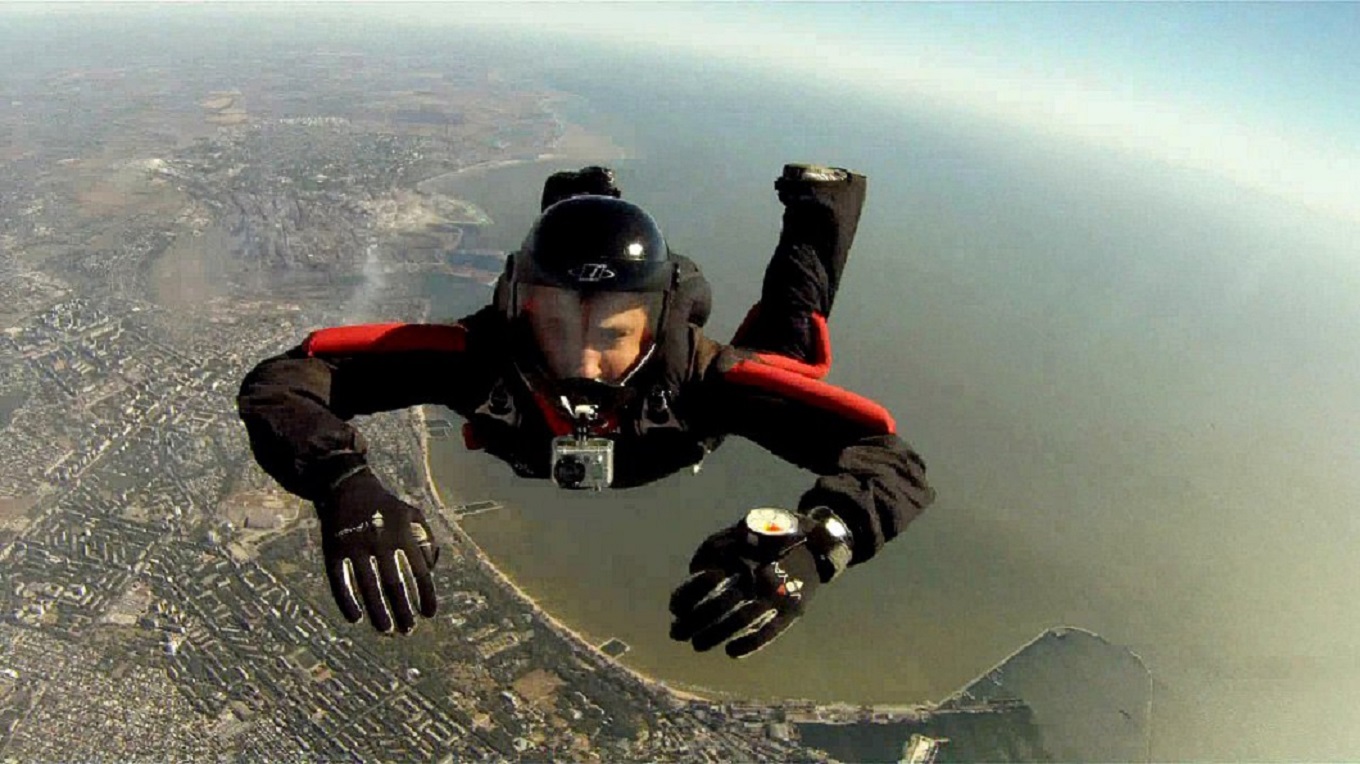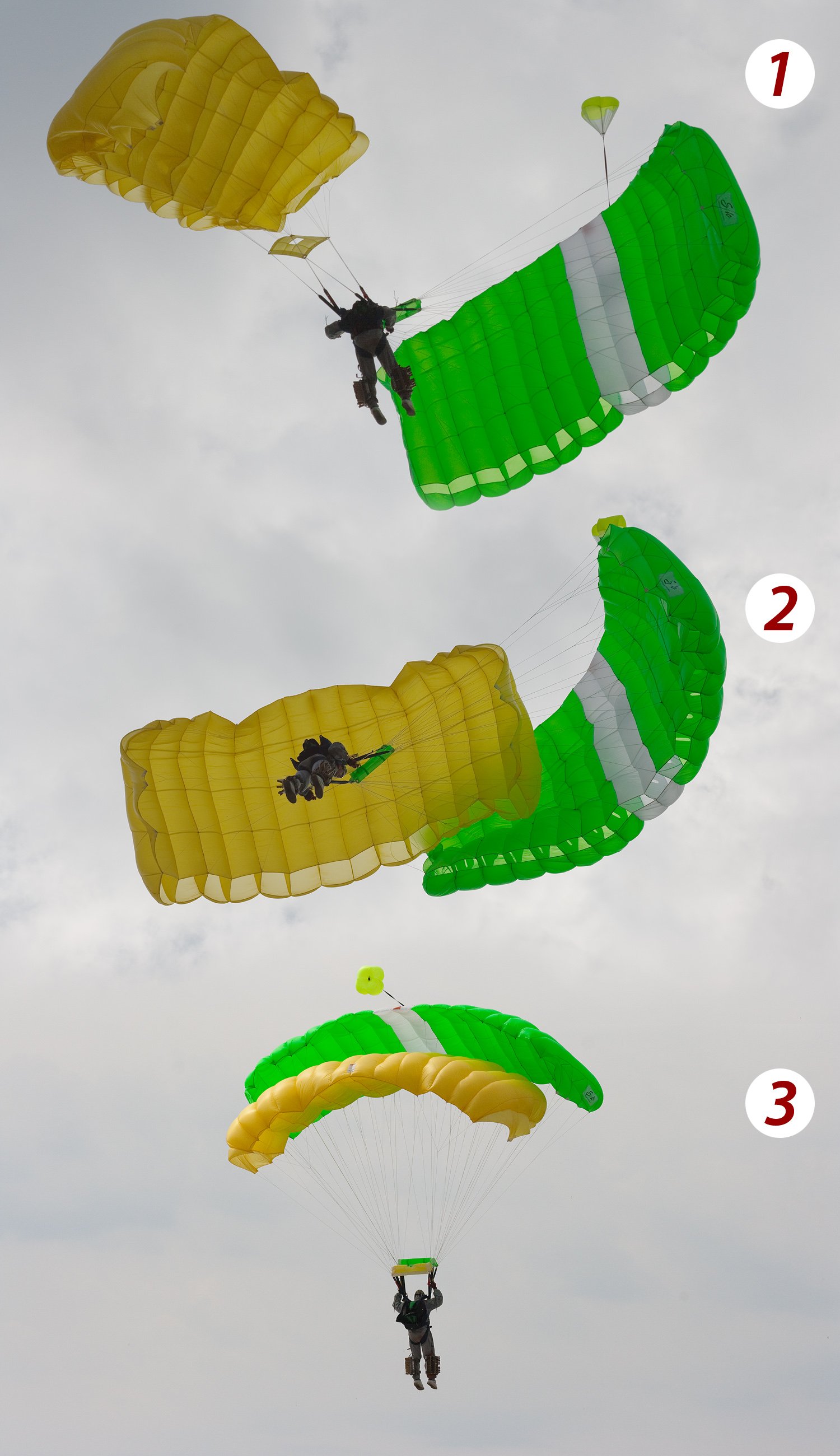|
Cut-away
{{Unreferenced, date=December 2009 Cut-away is a skydiving term referring to disconnecting the main parachute from the harness-container in case of a malfunction in preparation for opening the reserve parachute. The 3-ring release system on parachutes allows a rapid cut-away in the event of an emergency. '' Cutaway'' is also the title of a 2000 action film about skydiving. Modern skydiving harness-containers have two containers; one for the main parachute, and another one for the reserve. These containers are built into a single "backpack", with the reserve container above the main. In case the main parachute malfunctions, it is necessary to jettison the main before deploying the reserve to avoid a main-reserve entanglement. This act of jettisoning the main is called a "cut-away". Over the years, several different devices have been designed for cutting away the main. Among the most popular were variations of the Capewell release system, until in the 1970s, Bill Booth Bil ... [...More Info...] [...Related Items...] OR: [Wikipedia] [Google] [Baidu] |
Skydiving
Parachuting, including also skydiving, is a method of transiting from a high point in the atmosphere to the surface of Earth with the aid of gravity, involving the control of speed during the descent using a parachute or parachutes. For human skydiving, it may involve a phase of more or less free-falling (the skydiving segment) which is a period when the parachute has not yet been deployed and the body gradually accelerates to terminal velocity. For cargo parachuting, the parachute descent may begin immediately, such as a parachute-airdrop in the lower atmosphere of Earth, or be significantly delayed, such as in a planetary atmosphere where an object is descending "under parachute" following atmospheric entry from space, and may begin only after the hypersonic entry phase and initial deceleration that occurs due to friction with the thin upper atmosphere. History Common uses Parachuting is performed as a recreational activity and a competitive sport, and is widel ... [...More Info...] [...Related Items...] OR: [Wikipedia] [Google] [Baidu] |
Parachute
A parachute is a device used to slow the motion of an object through an atmosphere by creating drag or, in a ram-air parachute, aerodynamic lift. A major application is to support people, for recreation or as a safety device for aviators, who can exit from an aircraft at height and descend safely to earth. A parachute is usually made of a light, strong fabric. Early parachutes were made of silk. The most common fabric today is nylon. A parachute's canopy is typically dome-shaped, but some are rectangles, inverted domes, and other shapes. A variety of loads are attached to parachutes, including people, food, equipment, space capsules, and bombs. History Middle Ages In 852, in Córdoba, Spain, the Moorish man Armen Firman attempted unsuccessfully to fly by jumping from a tower while wearing a large cloak. It was recorded that "there was enough air in the folds of his cloak to prevent great injury when he reached the ground." Early Renaissance The earliest evidence f ... [...More Info...] [...Related Items...] OR: [Wikipedia] [Google] [Baidu] |
Malfunction (parachuting)
A malfunction is a partial or total failure of a parachuting device to operate as intended. Malfunctions may require a skydiver to cut away their main parachute and deploy the reserve parachute. High-speed malfunctions Pilot chute in tow This happens with the popular throw-out deployment system where the pilot chute does not pull the pin and open the container or once opened does not exert enough force to extract the deployment bag from the container. It can be caused by pilot chutes with kill lines that have not been cocked during packing or where the kill line has shrunk through use and reduces the drag of the pilot chute. It can be caused by a mis-routed pilot chute bridle. It can also be caused by too large a deployment bag and canopy for the container, although deployment bags should be matched to the containers. The correct procedure with this malfunction is to deploy the reserve from a stable belly down position. If time permits, the skydiver might first attempt to bump ... [...More Info...] [...Related Items...] OR: [Wikipedia] [Google] [Baidu] |
3-ring Release System
The 3-ring release system is a parachute component that is widely used by sport skydivers and military freefall parachutists to attach the two risers of a main parachute to the harness that bears the load under the parachute. Invented in its original large ring form by Bill Booth, and subsequently scaled down for thinner Type 17 webbing risers the three-ring system allows a skydiver to quickly cut-away a malfunctioning main parachute with a single motion. Skydivers usually need to do this quickly during emergencies in which they need to deploy a reserve parachute. The three-ring system is simple, inexpensive, reliable, and requires fewer operations than earlier parachute release systems while reducing the physical force needed. The large bottom ring is securely attached to the skydiver's harness, the middle ring is securely attached to the end of the parachute riser, and the small ring is securely attached to the parachute riser above the middle ring. The middle ring is passed thr ... [...More Info...] [...Related Items...] OR: [Wikipedia] [Google] [Baidu] |
Cutaway (2000 Film)
''Cutaway'' is a 2000 American action television film about skydiving, co-written and directed by Guy Manos. The term "cut-away" is used frequently in the film, in reference to parachuting and also in reference to life in general.Buchanan 2003, p. 93. ''Cutaway'' stars Tom Berenger, Stephen Baldwin, Dennis Rodman, Maxine Bahns, Ron Silver, Casper Van Dien and Thomas Ian Nicholas. This was Rodman's third film. It aired on the USA Network on October 3, 2000. Plot When U.S. Customs agent Vic Cooper's personnel file is reviewed, it shows that he struggles to disassociate his undercover identities from his real one. Despite the file's recommendation that he not return to active duty, he is cleared for work by Lieutenant Brian Margate. His first action back is a raid on a Bimini-based seafood importer, who Cooper believes is smuggling drugs. He is embarrassed to find only shrimp on the aircraft, and the pilot goes free. Because Cooper personally witnessed drugs being loaded onto ... [...More Info...] [...Related Items...] OR: [Wikipedia] [Google] [Baidu] |
2000 In Film
The year 2000 in film involved some significant events. The top grosser worldwide was '' Mission: Impossible 2''. Domestically in North America, ''Gladiator'' won the Academy Awards for Best Picture and Best Actor (Russell Crowe). ''Dinosaur'' was the most expensive film of 2000 and a box-office success. __TOC__ Overview 2000 saw the releases of the first installment of popular film series ''X-Men'', '' Final Destination'', ''Scary Movie'', and ''Meet the Parents''. Among the films based on TV shows are '' Mission: Impossible 2'', ''Traffic'', '' The Adventures of Rocky and Bullwinkle'', ''Charlie's Angels'' and '' Rugrats in Paris: The Movie'' Among the movies based on books (and TV shows) is '' Thomas and the Magic Railroad''. The most acclaimed films of the year are ''Gladiator''; ''Traffic''; ''Crouching Tiger, Hidden Dragon''; ''American Psycho''; '' Almost Famous, Requiem for a Dream,'' and '' Erin Brockovich''. Highest-grossing films The top 10 films released in 20 ... [...More Info...] [...Related Items...] OR: [Wikipedia] [Google] [Baidu] |
Action Film
Action film is a film genre in which the protagonist is thrust into a series of events that typically involve violence and physical feats. The genre tends to feature a mostly resourceful hero struggling against incredible odds, which include life-threatening situations, a dangerous villain, or a pursuit which usually concludes in victory for the hero. Advancements in computer-generated imagery (CGI) have made it cheaper and easier to create action sequences and other visual effects that required the efforts of professional stunt crews in the past. However, reactions to action films containing significant amounts of CGI have been mixed, as some films use CGI to create unrealistic, highly unbelievable events. While action has long been a recurring component in films, the "action film" genre began to develop in the 1970s along with the increase of stunts and special effects. This genre is closely associated with the thriller film, thriller and adventure film, adventure genres and ma ... [...More Info...] [...Related Items...] OR: [Wikipedia] [Google] [Baidu] |
Capewell Release System
Capewell is a surname. Notable people with the surname include: * Bill Capewell (born 1878), former professional footballer, where he played in the Football League for Stoke * George Capewell (1843–1919), American inventor, born in Birmingham, England * Len Capewell (1895–1978), English professional footballer whose playing position was of a forward * Les Capewell (born 1948), retired English professional darts player who competed in the 1980s * Luke Capewell (born 1989), Australian professional rugby league footballer {{surname ... [...More Info...] [...Related Items...] OR: [Wikipedia] [Google] [Baidu] |
Bill Booth
Bill Booth (born 1946 in Coral Gables, Florida) is an American engineer, inventor, and entrepreneur in the skydiving equipment manufacturing industry. His invention of the 3-ring release system, 3-ring release safety device has enhanced skydiving safety. He founded the companies United Parachute Technologies and Complete Parachute Solutions, which had 150 employees as of 2015. Work Bill Booth began skydiving in 1965, and in 1972 started a skydiving equipment company based in a Miami garage. In the late 1970s, Booth made two skydiving inventions. First he invented and patented the Hand Deploy Pilot Chute System. Later, he invented the 3-ring release system. The company's first harness/container system was the Wonderhog in 1974. This was followed by the Wonderhog Sprint and in 1980 by the Vector. The U.S. Skydiving Team wore the first Vectors at the 1981 World Meet. The Vector II followed six years later. In 1983, Booth received the Parachute Equipment Industry Association Ach ... [...More Info...] [...Related Items...] OR: [Wikipedia] [Google] [Baidu] |
3-ring Release
The 3-ring release system is a parachute component that is widely used by sport skydivers and military freefall parachutists to attach the two risers of a main parachute to the harness that bears the load under the parachute. Invented in its original large ring form by Bill Booth, and subsequently scaled down for thinner Type 17 webbing risers the three-ring system allows a skydiver to quickly cut-away a malfunctioning main parachute with a single motion. Skydivers usually need to do this quickly during emergencies in which they need to deploy a reserve parachute. The three-ring system is simple, inexpensive, reliable, and requires fewer operations than earlier parachute release systems while reducing the physical force needed. The large bottom ring is securely attached to the skydiver's harness, the middle ring is securely attached to the end of the parachute riser, and the small ring is securely attached to the parachute riser above the middle ring. The middle ring is passed thr ... [...More Info...] [...Related Items...] OR: [Wikipedia] [Google] [Baidu] |
Hook Knife
A hook is a tool consisting of a length of material, typically metal, that contains a portion that is curved or indented, such that it can be used to grab onto, connect, or otherwise attach itself onto another object. In a number of uses, one end of the hook is pointed, so that this end can pierce another material, which is then held by the curved or indented portion. Some kinds of hooks, particularly fish hooks, also have a barb, a backwards-pointed projection near the pointed end of the hook to ensure that once the hook is embedded in its target, it can not easily be removed. Variations * Bagging hook, a large sickle or reaping hook used for harvesting grain * Bondage hook, used in sexual bondage play * Cabin hook, a hooked bar that engages into an eye screw, used on doors * Cap hook, hat ornament of the 15th and 16th centuries * Cargo hook (helicopter), different types of hook systems for helicopters * Crochet hook, used for crocheting thread or yarn * Drapery hook, for h ... [...More Info...] [...Related Items...] OR: [Wikipedia] [Google] [Baidu] |




